Aromatherapy can offer comforting benefits for individuals with late-stage Alzheimer’s by reducing agitation and promoting relaxation through familiar scents like lavender, chamomile, or vanilla. Safe use involves proper dilution, gentle diffusion, and observing responses to guarantee comfort and safety. Techniques such as maintaining consistent environments and combining scents with calming routines help foster feelings of safety and emotional well-being. To learn more about creating a soothing aromatherapy approach, keep exploring these helpful strategies.
Key Takeaways
- Aromatherapy reduces agitation, anxiety, and promotes relaxation through familiar scents like lavender, chamomile, and vanilla.
- Proper diffusion and dilution ensure safe, effective use of essential oils to create a calming environment.
- Consistent, familiar scents help reinforce feelings of safety and emotional comfort for late-stage Alzheimer’s patients.
- Observing responses and adjusting scent intensity prevent distress and enhance therapeutic benefits.
- Combining aromatherapy with gentle touch and environmental consistency supports overall emotional well-being.
Understanding the Benefits of Aromatherapy for Late-Stage Alzheimer’s
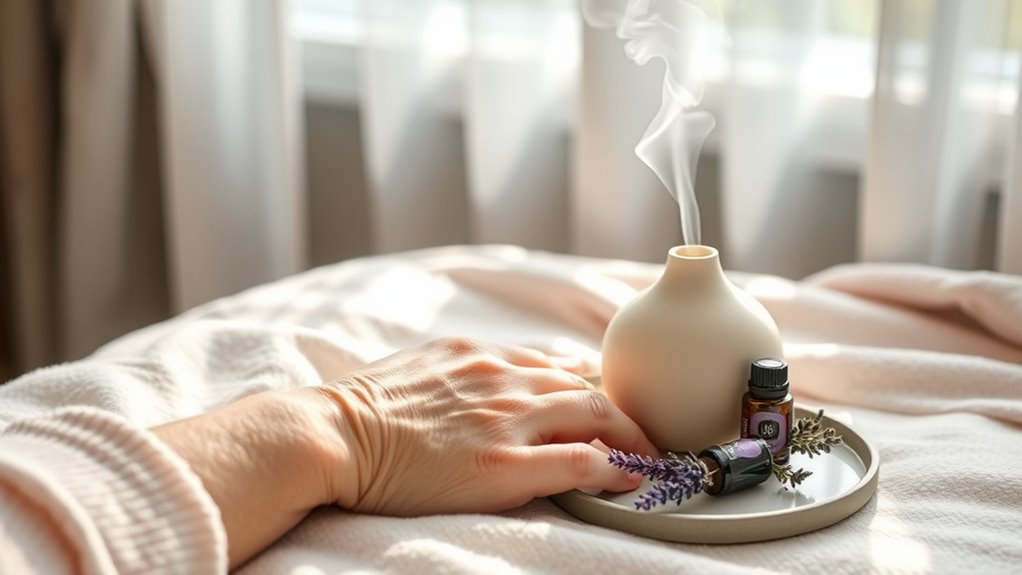
Aromatherapy offers a gentle and non-invasive way to improve comfort for those in late-stage Alzheimer’s. You might notice it helps reduce agitation, anxiety, and restlessness, making daily routines more manageable. Certain scents can promote feelings of safety and familiarity, providing reassurance during stressful moments. Aromatherapy can also support better sleep patterns, helping your loved one rest more peacefully. By engaging the senses, it encourages relaxation without the need for medication. Additionally, it can serve as a comforting ritual, strengthening emotional connections. While individual responses vary, many find that the right scents create a calming environment that enhances overall well-being. Incorporating sensory stimulation techniques like aromatherapy can further support emotional and physical comfort. Enhancing sensory engagement through natural methods like essential oils can amplify the calming effects. This natural approach offers a simple, safe way to help improve quality of life for those facing advanced Alzheimer’s. Moreover, understanding the benefits of aromatherapy can help caregivers tailor their approach to meet individual needs effectively.
Essential Oils That Promote Relaxation and Calmness
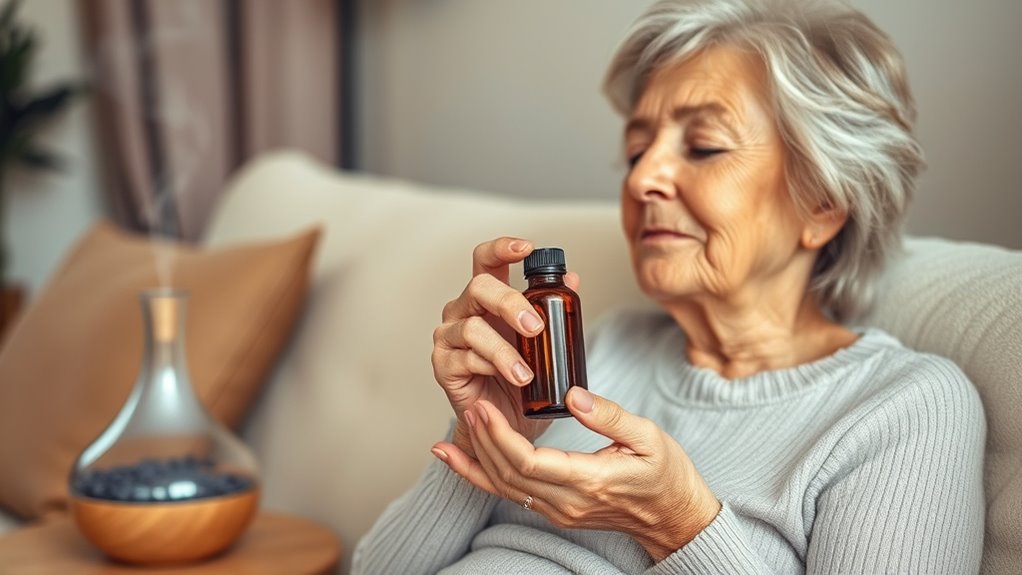
Certain scents have a powerful ability to promote relaxation and calmness in those with late-stage Alzheimer’s. Lavender is one of the most effective, known for its soothing properties that help reduce agitation and anxiety. Chamomile offers gentle calming effects, promoting restful sleep and easing tension. Bergamot can lift spirits while encouraging a sense of tranquility. Frankincense is often used to ground and center, helping to decrease feelings of distress. Ylang-ylang not only relaxes but also improves mood. These essential oils can be diffused or applied topically in diluted form to create a calming environment. Incorporating aromatherapy techniques into daily routines can help your loved one experience moments of peace and comfort amid their condition. Automation technologies are also being explored to customize calming interventions, enhancing the effectiveness of aromatherapy. Additionally, selecting oils with therapeutic properties can further support emotional well-being. Utilizing climate control methods, such as maintaining a comfortable room temperature, can also enhance the overall calming effect of aromatherapy. Implementing space maximization strategies in the environment can help create a more serene and organized setting that complements the calming effects of aromatherapy.
Safe Practices for Using Aromatherapy With Alzheimer’S Patients
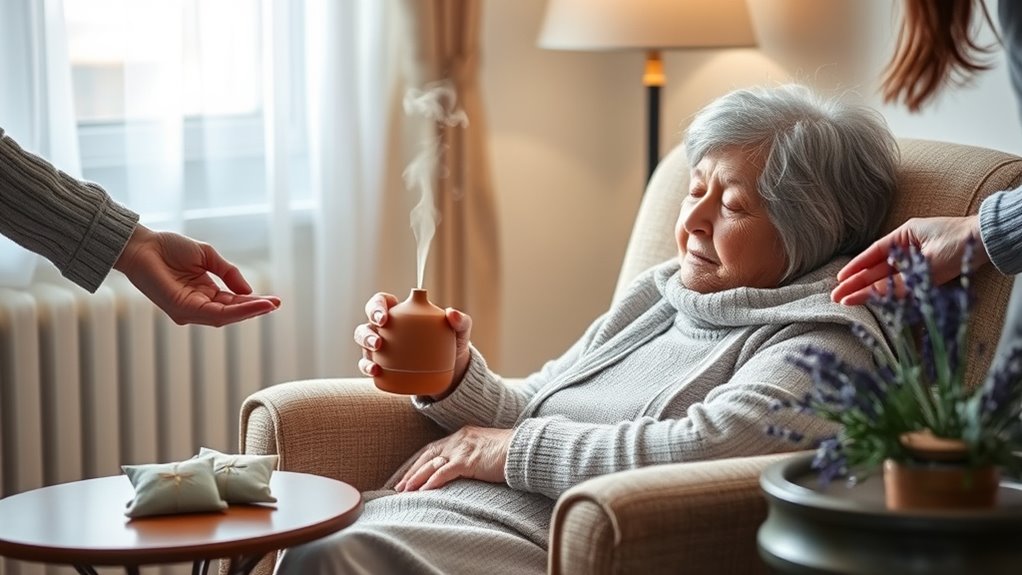
To guarantee safety, you need to use proper dilution techniques when applying essential oils to Alzheimer’s patients. It’s also important to select only safe, well-known oils and watch closely for any reactions. Staying vigilant helps protect your loved one while they experience the benefits of aromatherapy. Incorporating best practices for aromatherapy ensures that the treatment remains safe and effective. Additionally, understanding the safe use of essential oils can help prevent adverse effects and promote a positive experience. Using dog-safe essential oils can further safeguard your loved one from potential sensitivities. Implementing proper dilution techniques can significantly reduce the risk of irritation or adverse reactions in sensitive individuals. Being aware of the WWE Raw’s financial impact highlights the importance of informed decision-making in entertainment and health choices.
Proper Dilution Techniques
Because essential oils are highly concentrated, it’s crucial to dilute them properly before use with Alzheimer’s patients. Proper dilution minimizes the risk of irritation or adverse reactions. Typically, a safe starting point is one drop of essential oil per teaspoon of carrier oil, such as almond or coconut oil. Always follow recommended guidelines and consult with healthcare professionals. Remember, safe dilution is about protecting your loved ones while maximizing comfort. Keep these principles in mind:
- Use high-quality, pure oils to ensure safety and effectiveness
- Test a small patch of skin for sensitivity before full application
- Stick to recommended dilution ratios to prevent overstimulation or harm
Selecting Safe Essential Oils
Choosing the right essential oils is crucial to guarantee safety and comfort when using aromatherapy with Alzheimer’s patients. Opt for oils known for their gentle, non-irritating properties. Avoid high-risk oils like cinnamon or clove, which can cause sensitivities. Select only pure, high-quality oils from reputable sources. Always verify that the oils are suitable for internal or topical use, depending on your application.
| Essential Oil | Benefits | Precautions |
|---|---|---|
| Lavender | Calming, soothing | Use in moderation; dilute properly |
| Chamomile | Relaxation aid | Avoid if allergic to plants in the Asteraceae family |
| Frankincense | Supports immune health | Test patch before use |
| Rose | Comfort, emotional balance | Ensure purity to prevent skin reactions |
Monitoring for Reactions
Monitoring for reactions is essential whenever you use aromatherapy with Alzheimer’s patients, as their ability to communicate discomfort may be limited. Watch closely for signs like agitation, skin irritation, or respiratory changes. Even subtle cues, such as facial expressions or body language, matter. Always start with a small amount of essential oil and observe for any adverse effects before increasing the dose. Keep a record of reactions to adjust your approach as needed.
Remember:
- Never ignore signs of distress or discomfort
- Remove the scent immediately if a reaction occurs
- Consult healthcare providers if unsure about symptoms
Being vigilant helps ensure safety and comfort, making aromatherapy a positive experience for your loved one.
Creating a Soothing Environment Through Scent
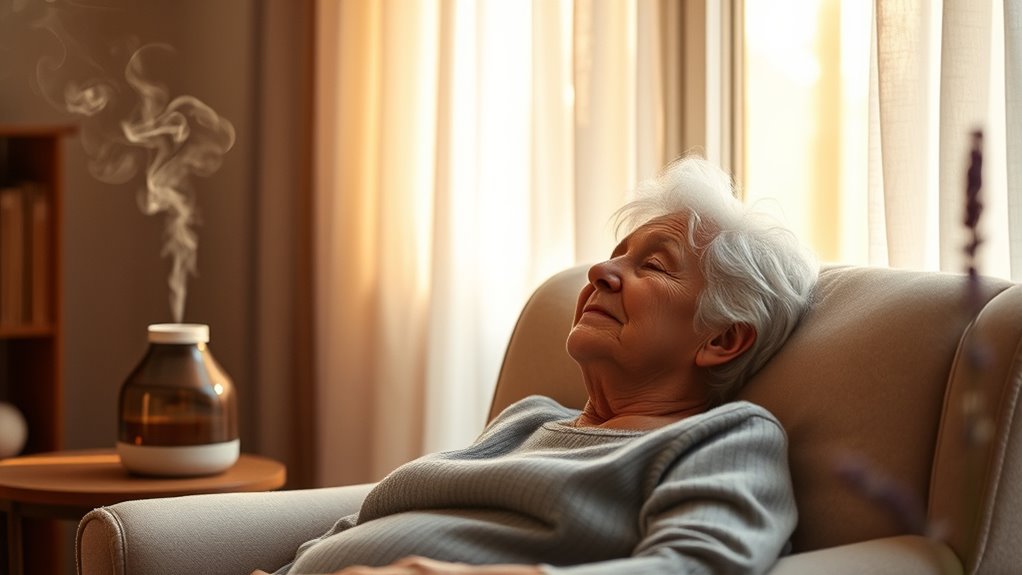
Creating a soothing environment through scent involves carefully selecting and diffusing aromas that evoke calm and familiarity. You want scents that comfort without overwhelming, helping your loved one feel safe and relaxed. Use gentle essential oils like lavender or chamomile, which promote peace. Diffuse these aromas in common areas or bedrooms to create a consistent, calming atmosphere. Keep the scent levels subtle to avoid overstimulation. Consistency is key—regularly using familiar scents helps reinforce a sense of security. Incorporating local ingredients that have a lasting cultural significance can also enhance the comforting effect, as familiarity plays a crucial role in reducing anxiety and promoting well-being. Understanding the importance of AI safety measures can help ensure that the development of new scent technologies remains trustworthy and safe. Additionally, integrating regional flavors and traditions can deepen the emotional connection and comfort provided by the scents you choose. Leveraging sensory associations can further deepen the calming impact of the scents you choose. Here’s a simple visual to guide your choices:
| Scent Type | Effect |
|---|---|
| Lavender | Calms anxiety, promotes sleep |
| Chamomile | Eases agitation, relaxes |
| Rose | Comforts and uplifts |
| Vanilla | Creates warmth and familiarity |
Techniques for Administering Aromatherapy Effectively

To administer aromatherapy effectively, you need to use proper diffusion methods and safe application techniques. Keep a close eye on your loved one’s reactions and adjust as needed to guarantee comfort. Being attentive helps you respond quickly and maintain a calming environment. Utilizing safe diffusers can help ensure that essential oils are dispersed evenly and safely. Additionally, understanding proper application techniques can prevent potential skin sensitivities or adverse reactions. Using appropriate dilution of essential oils is also crucial to avoid irritation and ensure comfort during use. Moreover, familiarity with local laws and regulations concerning essential oils can help ensure safe and compliant use. Consulting guidelines on Gold IRA management can also be beneficial if investing in precious metals for long-term security.
Proper Diffusion Methods
Using the right diffusion methods guarantees that aromatherapy provides consistent and safe relief for those with late-stage Alzheimer’s. Proper diffusion ensures essential oils are effectively dispersed without overwhelming the senses. To do this, select the appropriate device—diffusers like ultrasonic, nebulizing, or evaporative types. Always follow manufacturer instructions for ideal use. Keep the diffuser in a safe, accessible location, away from direct contact with skin or eyes. Adjust the scent intensity based on the individual’s response, avoiding overpowering fragrances. Remember these key points:
- Choose a diffuser suited to the space and needs
- Regularly clean devices to prevent contamination
- Use the correct amount of essential oil for effective diffusion
These steps help maintain a safe, calming environment.
Safe Application Techniques
Effective application techniques guarantee that aromatherapy remains safe and beneficial for individuals with late-stage Alzheimer’s. Always dilute essential oils properly before use to prevent skin irritation or adverse reactions. When applying topically, use carrier oils like coconut or jojoba, and test a small skin area first. Avoid direct contact with eyes, ears, or sensitive mucous membranes. Inhalation methods, such as diffusers or placing a few drops on a tissue, should be gentle and well-ventilated to prevent overwhelming the person. Keep sessions short, around 10-15 minutes, and monitor for any signs of discomfort or adverse reactions. Never force aromatherapy if it causes distress. Following proper techniques guarantees a safe, soothing experience that supports comfort without risking harm.
Observation and Response
Monitoring your loved one’s reactions during aromatherapy is essential to guarantee it remains comfortable and safe. Pay close attention to their facial expressions, body language, and any signs of distress or relaxation. If they show discomfort, such as fidgeting, grimacing, or withdrawal, gently stop or modify the scent. When they appear calm or respond positively, continue to observe their cues to ensure ongoing comfort. Remember, each person’s response is unique, so responsiveness is key.
- Recognize subtle signals of discomfort or pleasure
- Adjust scent intensity or duration based on reactions
- Know when to pause or stop altogether for safety
Recognizing and Responding to Individual Preferences
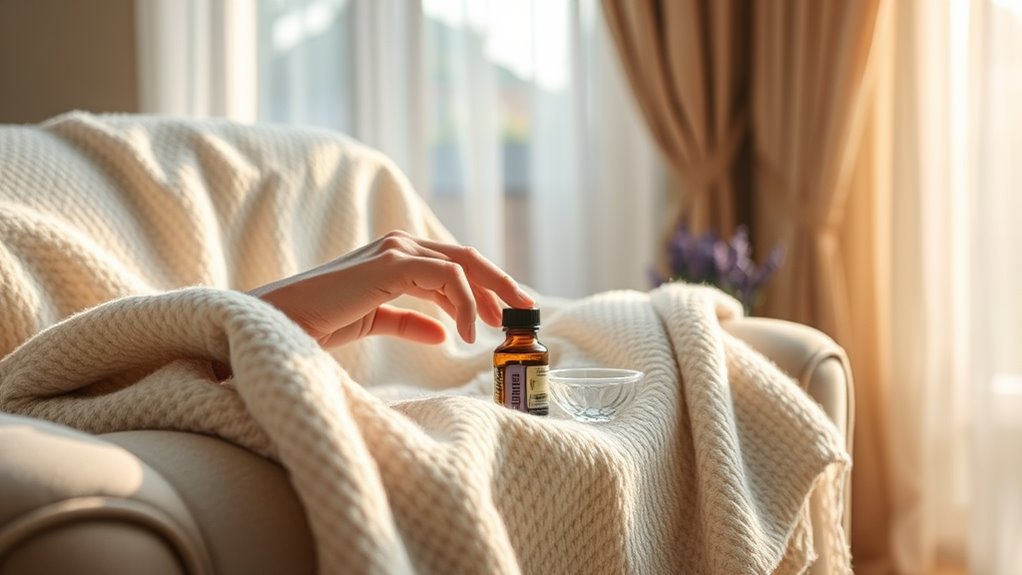
Understanding and honoring each person’s unique preferences is essential when providing comfort through aromatherapy in late-stage Alzheimer’s. Pay close attention to their reactions to different scents, noting which aromas seem to soothe or agitate them. Observe subtle cues like facial expressions, body language, or changes in mood to gauge their responses. Keep in mind that preferences can change over time, so regularly reassess their likes and dislikes. Engage with family members or caregivers who know the individual well—they can offer valuable insights into their scent preferences. Incorporating mindfulness techniques, such as attentive observation and active listening, can further enhance your ability to tailor aromatherapy to each person’s needs, creating a more supportive and comforting environment that respects their individuality.
Potential Risks and How to Minimize Them

While aromatherapy can offer comfort, it also carries potential risks that you should not overlook. Essential oils are potent and may cause adverse reactions if misused. To minimize risks, always dilute oils properly before use, test a small area for skin sensitivity, and avoid direct contact with eyes or mucous membranes. Be cautious with certain oils that can trigger allergic reactions or respiratory issues. Keep essential oils out of reach of the person you’re caring for, especially if they tend to put objects in their mouth. Use only high-quality, pure oils from reputable sources. Regularly monitor their response during aromatherapy sessions and discontinue use if any adverse effects occur. Staying informed and cautious helps guarantee safety while providing comfort through aromatherapy.
Integrating Aromatherapy Into Daily Care Routines

Integrating aromatherapy into daily care routines can seamlessly enhance comfort and create a calming environment for someone with late-stage Alzheimer’s. To do this effectively, incorporate diffusing essential oils like lavender or chamomile during activities such as dressing, grooming, or mealtime. Keep safety in mind by using diluted oils and ensuring proper ventilation. You might also apply calming scents through personal inhalers or topical methods, like a gentle massage with diluted oil on the hands or arms. Consistency is key—using the same scents at regular times helps your loved one associate them with comfort. Observe their reactions and adjust the intensity or timing as needed. By weaving aromatherapy into everyday moments, you can foster a soothing atmosphere that promotes relaxation and reduces agitation.
Additional Complementary Approaches to Comfort and Well-Being
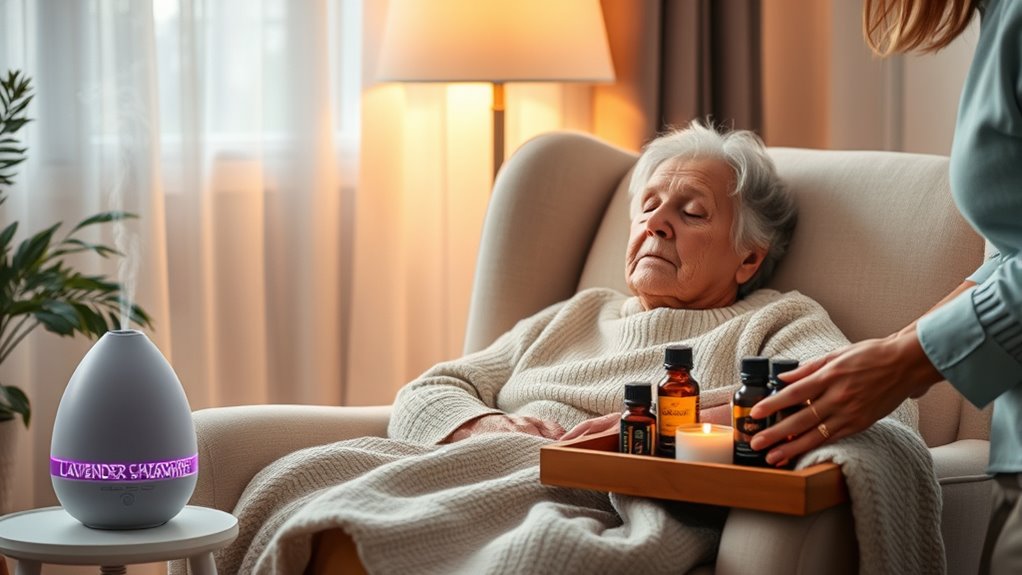
Complementing aromatherapy with other gentle approaches can further enhance comfort and emotional well-being for someone in late-stage Alzheimer’s. You might incorporate activities that evoke positive memories, like listening to familiar music or engaging in simple, sensory-focused tasks. Gentle touch, such as hand massages or soothing strokes, can foster connection and reduce anxiety. Creating a calm, familiar environment helps minimize confusion and agitation. Consider these approaches:
- Using music therapy to evoke memories and emotional responses
- Engaging in gentle, purposeful touch to reinforce connection
- Maintaining a consistent, soothing environment to reduce stress
These methods complement aromatherapy by addressing emotional needs holistically, helping your loved one feel safe, valued, and more comfortable. Combining these strategies can improve overall well-being and ease daily challenges.
Frequently Asked Questions
How Long Does It Take to See Benefits From Aromatherapy in Late-Stage Alzheimer’S?
You might wonder how quickly you’ll notice benefits from aromatherapy. Typically, if you use it consistently, some improvements like relaxation or reduced agitation can appear within a few days to a week. However, everyone’s different, and it might take longer for others. Keep track of your loved one’s responses, and stay patient. Regular use and proper application are key to maximizing the potential benefits of aromatherapy.
Can Aromatherapy Replace Other Comfort Care Practices for Alzheimer’S Patients?
Did you know that 78% of caregivers report improved patient comfort with complementary therapies? You can’t rely solely on aromatherapy to replace other comfort care practices for Alzheimer’s patients. Instead, see it as a supportive tool that enhances existing strategies like gentle touch, music, and proper nutrition. Combining approaches offers the best chance to improve quality of life, making your care more compassionate and effective.
Are There Specific Times of Day When Aromatherapy Is Most Effective?
You might wonder when aromatherapy works best. Morning and evening are often ideal, as these times help set a calming tone and promote relaxation before bedtime or after waking. During stressful moments or agitation, using aromatherapy can quickly soothe and re-center your loved one. Pay attention to their responses, and try to incorporate scents at consistent times to maximize comfort and effectiveness throughout the day.
How Do I Handle Adverse Reactions to Essential Oils in Patients?
When handling adverse reactions to essential oils, you should act quickly and calmly. Remove the patient from the source immediately, and gently cleanse the area with mild soap and water if skin irritation occurs. Monitor their breathing and critical signs, and if symptoms worsen or involve difficulty breathing, seek emergency medical help. Always keep emergency contact info handy and document the incident for future reference.
Is Aromatherapy Suitable for All Late-Stage Alzheimer’S Patients Regardless of Condition?
You might wonder if aromatherapy suits every late-stage Alzheimer’s patient. While it can offer comfort, it’s not appropriate for everyone. You should assess each patient’s individual condition, sensitivities, and preferences. Always consult with a healthcare professional before starting, and monitor reactions carefully. If they show adverse effects or discomfort, stop immediately. Personalize treatments to ensure safety and maximize benefits, recognizing that each person’s response varies.
Conclusion
By incorporating aromatherapy into your loved one’s daily routine, you can create a calming, comforting space that eases their anxiety. Some might worry about sensitivities, but with proper precautions, you’ll find gentle scents can transform their environment into a peaceful haven. Imagine their face relaxing as familiar, soothing aromas fill the air—offering comfort and connection even in the most challenging late-stage moments.










